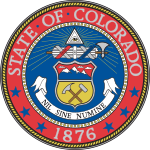| |||||||||||||||||||||||||||||||||||||
All 65 seats in the Colorado House of Representatives 33 seats needed for a majority | |||||||||||||||||||||||||||||||||||||
|---|---|---|---|---|---|---|---|---|---|---|---|---|---|---|---|---|---|---|---|---|---|---|---|---|---|---|---|---|---|---|---|---|---|---|---|---|---|
| |||||||||||||||||||||||||||||||||||||
 Results: Democratic hold Democratic gain Republican hold | |||||||||||||||||||||||||||||||||||||
| |||||||||||||||||||||||||||||||||||||
| Elections in Colorado |
|---|
 |
The 2018 Colorado House of Representatives elections took place as part of the biennial United States elections. Colorado voters elected state representatives in all 65 of the state house's districts. State representatives serve two-year terms in the Colorado House of Representatives. The Colorado Reapportionment Commission provides a statewide map of the state House here, and individual district maps are available from the U.S. Census here.
A primary election on June 26, 2018, determined which candidates appear on the November 6 general election ballot. Primary election results can be obtained from the Colorado Secretary of State's website.[1]
Following the 2016 state House elections, Democrats maintained effective control of the House with 37 members. However, on March 2, 2018, immediately before being expelled from the legislature in the face of sexual harassment allegations, State Representative Steve Lebsock switched parties to Republican. This forced his replacement to be a fellow Republican.[2] Due to these acts, Republican seats increased from 28 to 29 (Republican Alex Winkler was seated on March 23, 2018, to represent District 34) and Democratic seats decreased from 37 to 36 by election day 2018.
On election day, Democrats expanded their majority by 5 seats, as the party also swept all statewide elections in the state. To claim control of the chamber from Democrats, the Republicans would have needed to net 4 House seats.
- ^ "June 26, 2018 Primary Election Official Results". Colorado Secretary of State. Retrieved September 1, 2018.
- ^ "Rep. Steve Lebsock became a Republican minutes before being expelled from the legislature, meaning GOP get his seat". Denver Post. Retrieved September 1, 2018.


